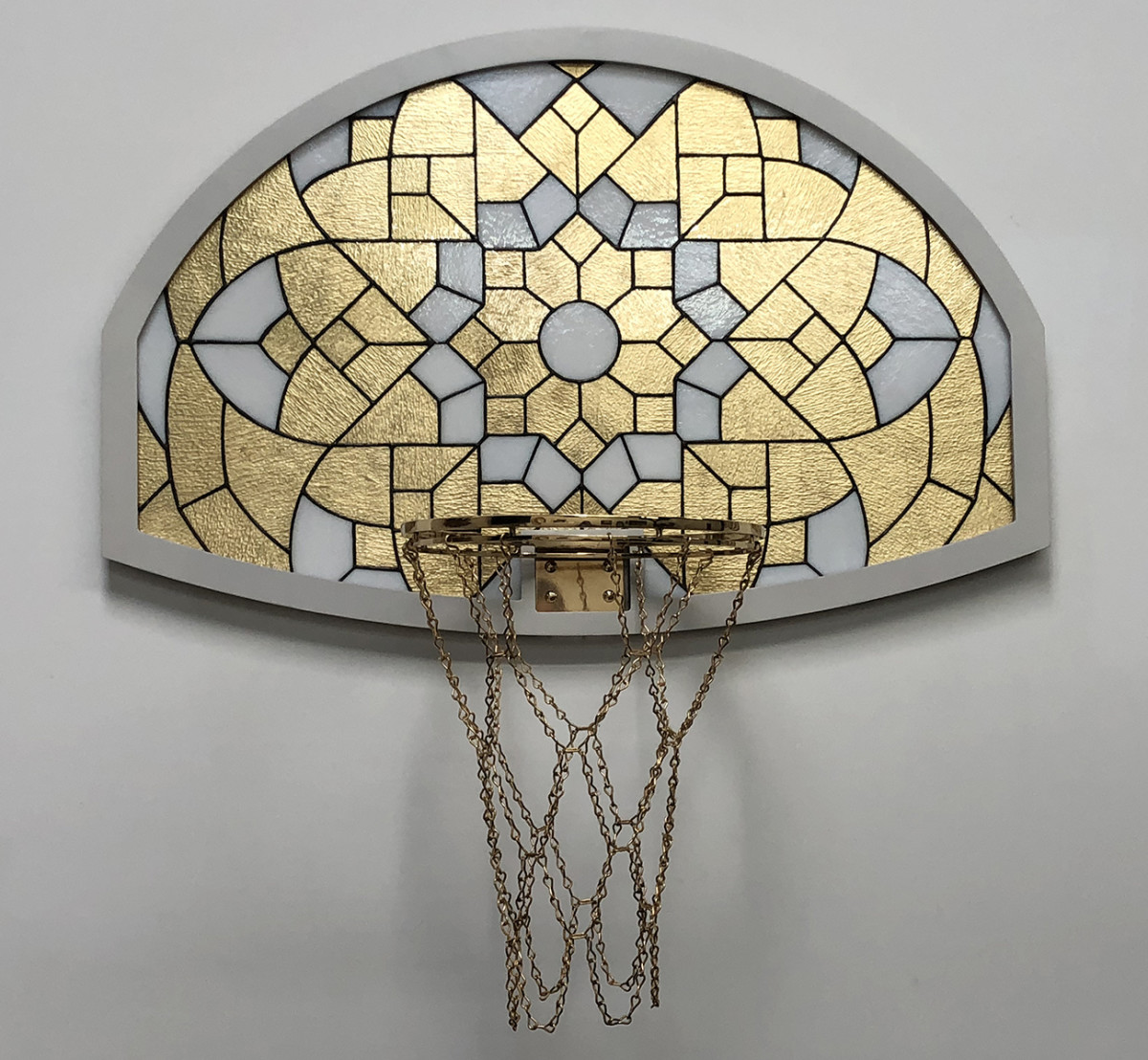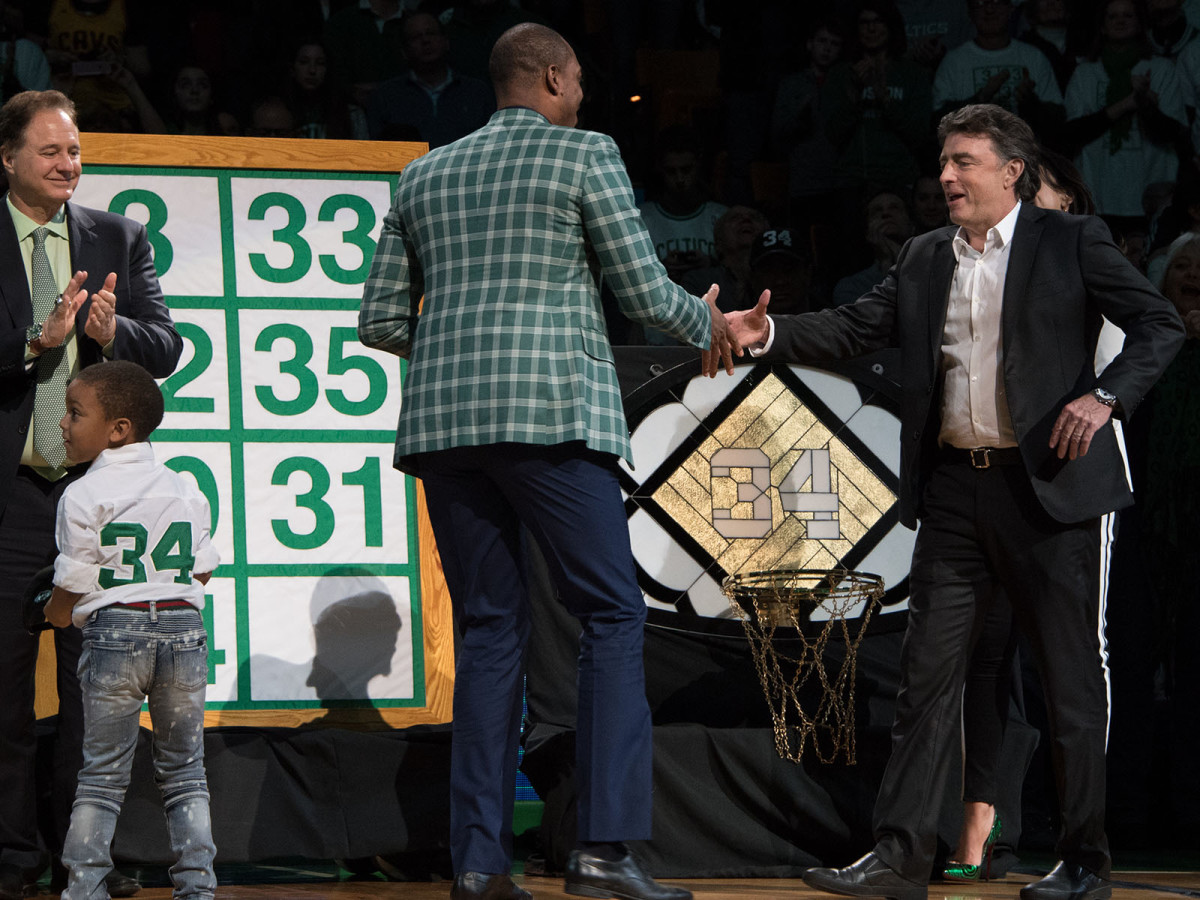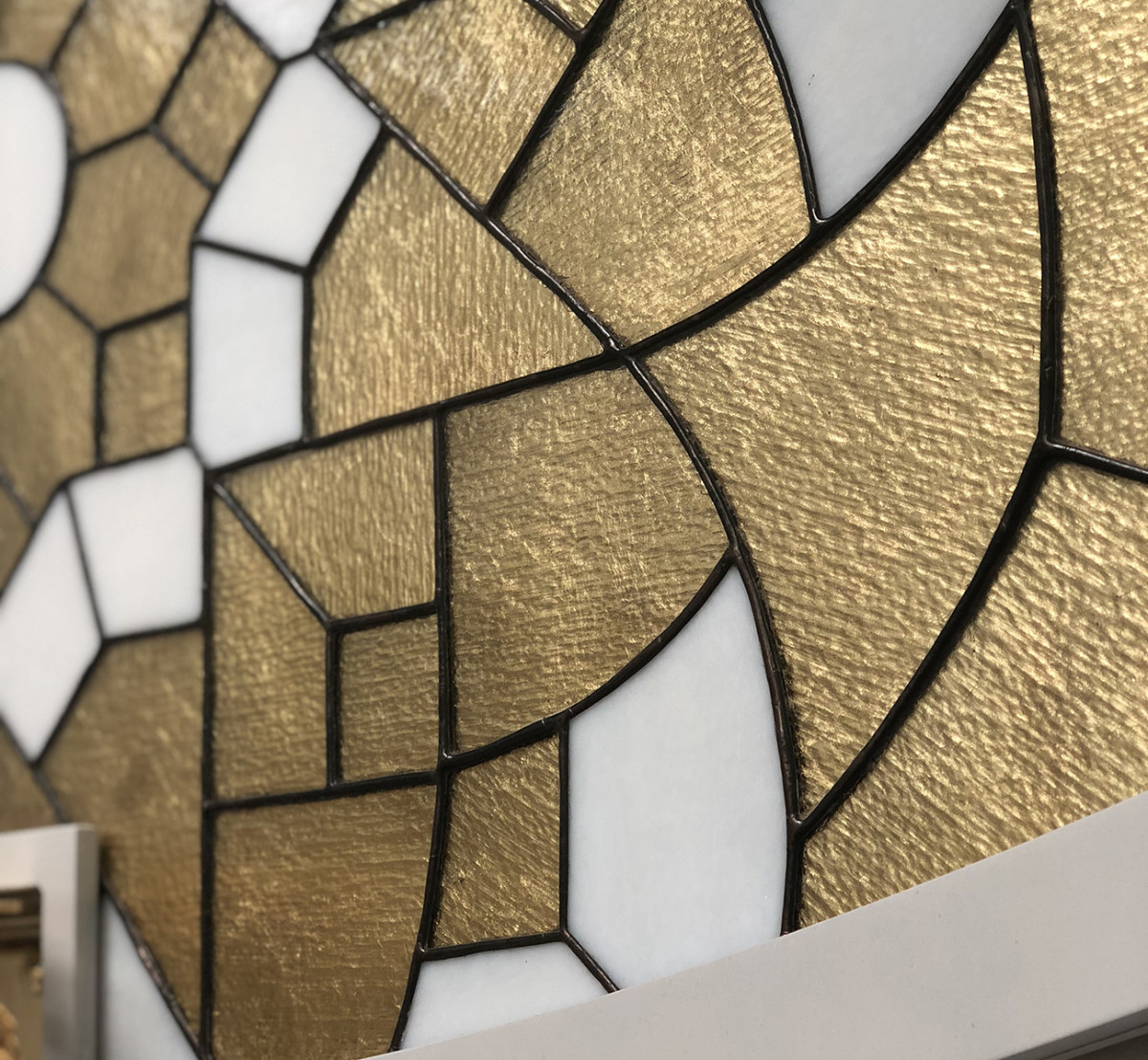Look But Don’t Dunk: Meet the NBA's New Bling King of Luxury Backboards

LOS ANGELES — No one needs a $30,000 hand-crafted, 24K-gold plated stained-glass basketball hoop with an accompanying Swarovski crystal net. But that hasn’t stopped artist Victor Solomon from dedicating years of his life to their painstaking creation.
Solomon, the NBA’s latest king of bling, toils deep within a nondescript industrial building—its flat concrete exterior painted black and its address barely visible—surrounded by auto shops, recycling centers and towing companies right off Interstate-10 in East LA. He spends upwards of 200 hours taking a single project from concept to finished product in his lightly-furnished one-room workshop, accompanied only by the voices in his earbuds, which range from Slate’s Watergate podcast to The Skyliners, the 1960s doo-wop group. His low-key presentation—black and white sweater, dark jeans, plain gold ring, and two thin chains tucked into his shirt—stands in stark contrast to his exceptionally high-key craft. He handles his most important business affairs by himself, and his only personal assistant is Baby, the rescue Chihuahua who swarms his ankles and greets guests.
Clearly, Solomon isn’t trying to mimic Jason of Beverly Hills or Jacob “the Jeweler” Arabo, prominent celebrity jewelers known for designing the Warriors’ ornate 2017 championship rings and Kanye West’s Jesus piece, respectively. Nevertheless, the Massachusetts-born, LA-based artist shares their top-dollar price range and target demographic of professional athletes and rappers. His stained-glass basket niche has proven to be profitable and growing—his pieces regularly sell for $20,000 to $30,000, or more—precisely because they are unnecessarily extravagant.
“My baskets are gaudy in a way that makes me laugh,” Solomon told The Crossover in an interview from his workshop. “Intentionally gaudy. I got interested in stained glass because it had such a rich history of wealth and displays of power, dating back to medieval times. Back in those days, because it was so expensive, kings used it to show peasants that they were the boss. Basketball has taken a dominant place in culture today: aesthetically, stylistically, even musically. These guys are modern royalty, and my baskets are a new way for them to flex and stunt.”

Solomon will unveil his most complex stained-glass work during NBA All-Star Weekend in LA but getting to this point required careful navigation into two exclusive clubs: the arts scene and the NBA universe. After a poor gallery showing in 2016 that ended with a contentious relationship with the studio owners, Solomon found himself turned off by the pretentiousness and occasional aimlessness of the people he was encountering on the art side. During a drive back to San Francisco, where he was living at the time, Solomon wondered whether it was time to pivot away from his luxury hoops. “I had that bad feeling,” he said. “I guess this is the end. My idea didn’t turn into anything.”
Serendipitously, his big break came shortly thereafter: A third-party reached out on behalf of Nike to gauge his interest in crafting a stained-glass backboard as a welcome gift to Kevin Durant, the newest member of the Golden State Warriors. That call eventually led Nike to commission one of his pieces, which was displayed at a San Francisco art gallery show that traced the 2014 MVP’s upbringing and interest in photography.
The breaks have continued to pour in since, with famous clients drawn both to his craftsmanship and his work’s status affirmation. “[Solomon’s pieces] are a celebration that you’ve beaten the odds [and that] you’re flush with money that you never thought you’d have,” said Nathaniel Friedman, a basketball and culture writer who edits the Victory Journal and founded Free Darko. “Balling out because you made it. For basketball players, they earned their wealth by themselves and this is the reward: the counter to an old-fashioned peach basket or shi--y plexiglass.”
The Celtics gifted one to Paul Pierce as part of his elaborate and much-ballyhooed jersey retirement ceremony on Sunday. Hip–hop producer Swiss Beatz became a Solomon supporter, and the rapper Rick Ross installed a stained-glass backboard next to the basketball court inside his Atlanta mansion. The rock singer and songwriter Bohnes purchased one of Solomon’s pieces for his new Nashville home, much to the delight of his basketball-loving girlfriend Josephine Skriver, the Victoria’s Secret model.
Durant’s grand backboard, which featured black and white circular designs and a crystal net, was included as one of numerous hoops that traced Durant’s life from his childhood in Maryland to his new home in the Bay. “I wanted to leave my mark as soon as I got here,” Durant told the crowd at San Francisco’s Terra Gallery. “This [exhibit] is something I've wanted to do for a while. It's been a passion project of mine. Thanks to Vic for doing his thing on this one.”
The Celtics came across Solomon’s work on social media and reached out to him in the months leading up to Pierce’s jersey retirement. Given that Pierce’s Celtics career spanned 15 seasons and included the 2008 title, the organization wanted to supply “The Truth” with an over-the-top send-off. They hosted an elegant reception dinner for Pierce and his former teammates under chandeliers at Boston’s Four Seasons hotel, and they staged an hour-long post-game ceremony featuring speeches from former coach Doc Rivers and president Danny Ainge. Pierce’s backboard—which included the No. 34 in the middle, a parquet background, Boston’s trademark shamrocks on the side, and a classic Celtic design—was presented during the on-court ceremony.
"The backboard is unbelievable," Pierce told The Crossover. "I'm going to put it in the trophy room at my house in L.A. Maybe I'll let my son Prince play on it."

Bohnes and Skriver, meanwhile, stumbled across Solomon’s work in a Manhattan art gallery, drawn in by its religious connotations and careful craftsmanship. “We were walking down 27th street and saw this incredible mosaic hoop in one of the galleries,” Bohnes, who grew up as a Lakers fan in Las Vegas, told The Crossover. “We fell in love with it the second we saw it. Captivating. Intriguing. Kobe Bryant is my favorite player to ever do it because he paid close attention to details. There’s nothing more detailed than one of these backboards.”
The black, white and gold backboard now hangs in Bohnes’s office, above two of his guitars. When he gets the urge to ball up a page of unusable lyrics, the 28-year-old musician heads to his recording studio and takes aim at a Little Tykes hoop. “Basketball is such a high-speed and aggressive sport, and I like that the backboard has this delicacy to it,” he said. “It’s too beautiful to touch.”
Solomon’s All-Star Weekend gallery will take place at 1052 S. Olive St., just a few blocks east of Staples Center. Unlike the singular, wall-mounted backboards he crafted for Durant and Pierce, the show’s centerpiece will include four different stained-glass backboards attached at right angles to a single free-standing stanchion. Solomon drew inspiration for the concept from the utilitarian four-in-one hoops that are commonly found at LA’s public schools. Following the LA unveiling, the centerpiece is scheduled for a world tour, with expected stops in Houston, New York City, Dubai and multiple cities in Europe.
The design process begins on Adobe Illustrator, where Solomon sketches the symmetrical designs and selects his glass color combinations. “Everything else in the process is so lo-fi that I wish I didn’t have to use a computer at all,” he said. “But it’s perfect for this.”
A lifelong Celtics fan born during Larry Bird’s heyday, Solomon always begins with the traditional backboard shape as his template, working out from where the center square appears on a regulation hoop. He then adds design elements out to the edge, planning out which individual pieces will be made of colored glass or mirror. From there, he breaks out the individual visual elements into separate pieces, gluing paper representations of each section to large sheets of colored glass prior to the cutting process. Using a grinder, he then cuts down the glass sections to their precise final shapes and then wraps them in copper foil.
“Imagine the backboard as a LEGO set,” he explained. “I’m building the final set, but first I’m building each of the individual bricks. It’s a very repetitive, meditative, time-intensive process. I didn’t consider this when I started, but the discipline that goes into it is similar to an athlete’s reps.”

Once the glass pieces are cut, he places them back into the backboard frame, like puzzle pieces. To connect the glass portions, he uses lead solder and then adds a patina finish before wrapping the entire piece in zinc. Once the glasswork is complete, he adds a hand-wrought steel rim and a brass chain net, both of which are 24K gold-plated. For an even flashier alternative, Solomon offers the Swarovski crystal nets.
While Solomon’s original inspiration came from medieval stained-glass, multiple art historians agreed that his works are more reminiscent of American artists from the late-19th and 20th centuries. His choices in color and geometric patterns, his use of machine molding, and his lack of depicted figures align more directly with Gilded Age artists like Louis Comfort Tiffany and John La Farge rather than earlier European glassworkers.
“American artists of the Gilded Age were aware of medieval works, but they were doing their own thing in designing pieces for the merchant banking families and great industrialists of their day,” said Aden Kumler, an art history professor at the University of Chicago. “[Similarly, Solomon] has his own way of presenting a contemporary notion of courtliness and glamour. … He’s not borrowing wholesale or directly quoting [from medieval works].”
Indeed, Solomon picked up the Tiffany style of glassmaking while apprenticing for a year at a stained-glass studio in San Francisco. A former aspiring filmmaker, he learned how to handle and treat glass from lifelong artisans who made high-end lamps, doors and window hangings. Applying the Tiffany process to a backboard—replacing plexiglass with stained glass—was a leap of faith that required a dedicated hoop head to conceive.
Five medieval art historians surveyed by The Crossover generally found Solomon’s modern application to be compelling, in large part because he chose to repurpose glass in such an unexpected fashion. “I was struck by the inherent fragility,” Kumler said. “A backboard is meant to take a whole bunch of blows, but this one needs to be treated with reverence.” University of Manitoba professor Jim Bugslag reacted even more sharply. “There is something disquieting about situating this medium in the context of a backboard,” he wrote in an email. “YOU ARE NOT SUPPOSED TO THROW THINGS AT STAINED-GLASS WINDOWS.”
If art should provoke, Solomon has succeeded.
While his backboards put Solomon on the map, he’s already plotting his next moves under his LiterallyBalling.com brand. At his workshop, he describes a series of prototype decorative basketballs that are in production: stainless steel, solid crystal, gold leaf, chrome-dipped. From a desk drawer, he pulls out a half-finished white wristband that features a Rolex-like chain-link pattern. “For me, it’s never been about the exhibition side of being an artist,” Solomon said. “The brainstorming and production parts are what I love.”
Shana Nys Dambrot, an art critic and curator based in LA, said that Solomon’s works stand apart from some of the most recognized sports-infused pieces of modern art. Artist Mark Bradford, she said, has repeatedly used soccer to represent “a universal language,” famously sculpting a series of paper mache soccer balls that were hung in a net. And Matthew Barney has utilized his background as a football player to inform violent sculptures and performance arts. Dambrot argued that Solomon is serious in his “production value” but, in contrast to Bradford and Barney, much more light-hearted in his worldview.
“[He’s] made these monumental, lavish shrines that celebrate and worship the game, but there’s a self-aware street humor in the tackiness,” she said. “It’s fun, pretty and shiny, while also displaying the extremely advanced technique. It’s sincere and cheeky at the same time.”
Solomon will be busy during All-Star Weekend. In addition to his own gallery showing, he partnered with Spalding, the NBA’s official basketball manufacturer, to gild 150 basketballs and arrange them in striking pyramid displays. The National Basketball Players Association also commissioned six engraved crystal basketballs and additional custom pieces for the lobby of their hotel over the weekend.
These inroads have Solomon thinking big on how else he might put his perspective to use. “My real dream is that I want to redesign the trophies for the NBA,” he said. “We’ve got to get new trophies. The trophies are wack. The Larry O’Brien is obviously untouchable, but a lot of the award trophies and the conference finals trophies are terrible. Imagine if you added touch illumination. The players go on this huge journey, they hold up the trophy, and then it lights up like the sword in the stone.”
The artist’s most grandiose vision, though, is far bigger than a player’s living-room ornament or a team’s trophy-case collection. Solomon, whose own hoop journey has carried him across the country, around the world and into the proximity of the sport’s biggest stars, wants to construct basketball’s answer to the “Field of Dreams” in Iowa.
“I want to build a court out of marble and drop it in the middle of nowhere,” he said, his eyes widening. “There’s a piece of land off Interstate-5 between San Francisco and LA that I’ve had my eye on. Marble court. Gold, playable versions of the baskets. This would be the spot where anyone on a road trip could swing by for a basketball pilgrimage. One day.”
For now, envisioning Solomon’s master plan is just like admiring one of his signature backboards. You can look, but you can’t touch.
